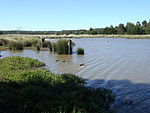Melbourne School of Theology
The Melbourne School of Theology (MST) is an evangelical Christian theological college with its main campus in Wantirna, an eastern suburb of Melbourne, Victoria, Australia. It offers undergraduate and post-graduate programs in biblical studies, pastoral studies, theology and related fields. The school has a Chinese department, known as MST Chinese, in which undergraduate and graduate courses are taught in both Mandarin and Cantonese which also has a postgraduate research section known as MST Centre for the Study of Chinese Christianity. In 2011 the main (Wantirna) campus relocated from the suburb of Lilydale in the outer eastern suburbs of Melbourne to its present location. The Chinese department, which used to operate in Box Hill, also relocated to the new campus and was renamed MST Chinese.
Excerpt from the Wikipedia article Melbourne School of Theology (License: CC BY-SA 3.0, Authors).Melbourne School of Theology
Mountain Highway, Melbourne Wantirna
Geographical coordinates (GPS) Address Website Nearby Places Show on map
Geographical coordinates (GPS)
| Latitude | Longitude |
|---|---|
| N -37.859722222222 ° | E 145.20916666667 ° |
Address
Melbourne School of Theology
Mountain Highway
3152 Melbourne, Wantirna
Victoria, Australia
Open on Google Maps






